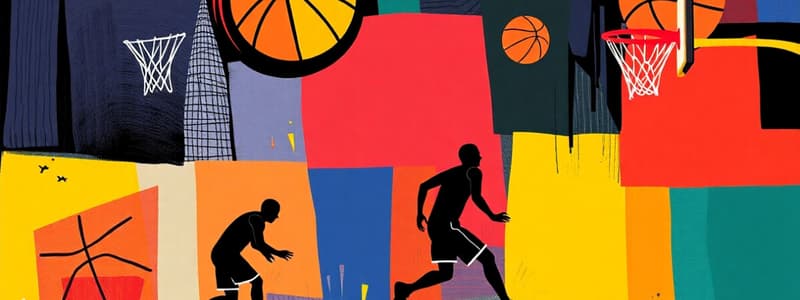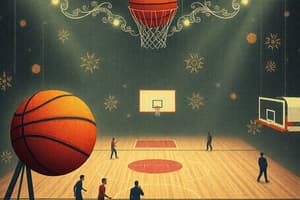Podcast
Questions and Answers
Why is wearing comfortable attire and footwear emphasized for basketball players?
Why is wearing comfortable attire and footwear emphasized for basketball players?
- To enhance marketability and team aesthetics.
- To adhere to strict uniform regulations enforced by referees.
- To improve player performance and prevent restrictions during play. (correct)
- To minimize the risk of injuries from contact with other players.
What was Dr. James Naismith's primary intention when he invented basketball in 1891?
What was Dr. James Naismith's primary intention when he invented basketball in 1891?
- To create a sport with complex rules and strategies.
- To invent a game using peach baskets as goals, with complex scoring.
- To develop a competitive international sport.
- To provide an indoor activity for YMCA leaders during the winter. (correct)
When pivoting in basketball, what is the key distinction between pivoting with the right foot versus the left foot?
When pivoting in basketball, what is the key distinction between pivoting with the right foot versus the left foot?
- Both feet can be used for pivoting either forward or backward, depending on the player's needs. (correct)
- Pivoting with the right foot is only possible moving backward, whereas pivoting with the left foot is only possible moving forward.
- Pivoting with the right foot is solely for offensive maneuvers, while pivoting with the left foot is for defensive movements.
- There is no functional difference; players can choose either foot based on personal preference.
Which basketball pass is most suitable for a smaller player trying to pass the ball around a taller defender?
Which basketball pass is most suitable for a smaller player trying to pass the ball around a taller defender?
In what scenario is the baseball or outlet pass MOST advantageous in basketball?
In what scenario is the baseball or outlet pass MOST advantageous in basketball?
What is the primary point of contact when dribbling a basketball, according to the guidelines provided?
What is the primary point of contact when dribbling a basketball, according to the guidelines provided?
What is the key difference between a protective/controlled dribble and a high/speed dribble?
What is the key difference between a protective/controlled dribble and a high/speed dribble?
Which of the following is an important element of maintaining balance during a shot?
Which of the following is an important element of maintaining balance during a shot?
What is the purpose of ensuring the elbows are not too close to the body when shooting a basketball?
What is the purpose of ensuring the elbows are not too close to the body when shooting a basketball?
What results from a violation in basketball?
What results from a violation in basketball?
What constitutes a 'carry' violation in basketball?
What constitutes a 'carry' violation in basketball?
During volleyball gameplay, what is the primary purpose of the 'pass' skill?
During volleyball gameplay, what is the primary purpose of the 'pass' skill?
In volleyball, what does the term 'set' refer to?
In volleyball, what does the term 'set' refer to?
Which action does 'serve' refer to in volleyball?
Which action does 'serve' refer to in volleyball?
What is the correct way to create a 'platform' for passing in volleyball?
What is the correct way to create a 'platform' for passing in volleyball?
In volleyball, what should a player NOT do while blocking the ball?
In volleyball, what should a player NOT do while blocking the ball?
What is the 'overhead (float)' serve in volleyball?
What is the 'overhead (float)' serve in volleyball?
When does a team rotate in volleyball, and in what direction?
When does a team rotate in volleyball, and in what direction?
How many hits are allowed per side in volleyball?
How many hits are allowed per side in volleyball?
Which of the following is a basic rule violation in volleyball?
Which of the following is a basic rule violation in volleyball?
Flashcards
Basketball's Origin
Basketball's Origin
Invented in 1891 by Dr. James Naismith to provide an indoor activity for YMCA leaders.
Basketball Violation
Basketball Violation
A violation occurs when a player breaks one of the basketball rules, resulting in the ball being awarded to the opposing team.
Chest Pass
Chest Pass
Ball is held in the chest area and thrown to the receiver by quickly extending the arms and hands.
Bounce Pass
Bounce Pass
Signup and view all the flashcards
Overhead Pass
Overhead Pass
Signup and view all the flashcards
Baseball/Outlet Pass
Baseball/Outlet Pass
Signup and view all the flashcards
Dribbling (Basketball)
Dribbling (Basketball)
Signup and view all the flashcards
Shooting (Basketball)
Shooting (Basketball)
Signup and view all the flashcards
Pass (Volleyball)
Pass (Volleyball)
Signup and view all the flashcards
Set (Volleyball)
Set (Volleyball)
Signup and view all the flashcards
Block (Volleyball)
Block (Volleyball)
Signup and view all the flashcards
Spike/Attack (Volleyball)
Spike/Attack (Volleyball)
Signup and view all the flashcards
Dig (Volleyball)
Dig (Volleyball)
Signup and view all the flashcards
Serve (Volleyball)
Serve (Volleyball)
Signup and view all the flashcards
Volleyball
Volleyball
Signup and view all the flashcards
Travelling Violation
Travelling Violation
Signup and view all the flashcards
Carry Violation
Carry Violation
Signup and view all the flashcards
Double Dribble
Double Dribble
Signup and view all the flashcards
Fouls
Fouls
Signup and view all the flashcards
Study Notes
Basketball History
- In 1891, Dr. James Naismith, a Canadian at Springfield College, Massachusetts, invented basketball.
- The International YMCA Training School sought an indoor activity for YMCA leaders, leading to the game's creation.
- Initially, peach baskets served as goals at each gymnasium end, giving rise to the name "basketball."
Basketball Facilities and Equipment
- Essential equipment includes a basketball court, backboard and rim, a ball, a game clock, manual and electronic scoreboards, a whistle, and possession arrows.
- Player attire should prioritize comfort and allow for free movement.
Basketball Skills and Movement
- Key movements involve sprinting, back pedaling, defensive slides, and pivoting with both feet in forward and backward directions.
- Stationary finger control drills are performed on the abdomen, chest and over the head.
- They are also performed rotating around the neck, waist and knees in both clockwise and counter-clockwise directions, including spiral movements.
Passing Technique
- Passing is a very important to quickly move the ball forward
- Chest Pass: Extending arms throws the ball from the chest area to a receiver.
- Bounce Pass: Throw the ball so it bounces about 2/3 of the distance to the receiver, useful for smaller players guarded by taller ones.
- Overhead Pass: A two-handed pass from above the head is effective when guarded by shorter players.
- Baseball/Outlet Pass: A one-handed pass used for longer distances, especially for fast breaks.
Dribbling Techniques
- Dribbling involves continuously bouncing the ball on the floor with one hand while moving.
- Dribbling variations include front, side, V-dribble, crossover, between the legs, behind the back, spin, and speed dribbles.
- Ball should be “touched” with fingertips, not the palm.
Protective Dribbling
- Maintain an athletic stance with bent knees and a low body position.
- Use the free hand to guard the ball and keep the head up to see teammates.
- Dribble on the outer part of the body.
Speed Dribbling
- Dribble from waist to chest height.
- Push the ball forward and catch up to it.
Shooting the ball
- Shooting involves throwing the ball toward the hoop and net.
- Shot types include spot shooting, lay-ups, free throws, jump shots, hook shots, and bank shots.
Shot Form
- Feet remain shoulder-width apart, nearly parallel with the shooting foot slightly forward.
- Keep toes pointed toward the target.
- Air hole of the ball located between the middle and index fingers.
- The palm doesn't touch the ball; use finger pads and spread fingers for grip.
- Use non-shooting hand for support and balance.
- Keep elbows away from the body.
- Place ball above the forehead with a flexed wrist.
Generating Shooting Power
- Keep eyes on the rim once you have established your stance and grip.
- Use bent knees to generate power, straightening the knee (or jumping).
- Extend elbow and wrist toward the basket, releasing the ball off the fingertips for backspin.
- Follow through, keeping the wrist relaxed and pointed toward the target after release.
Basketball positions
- Positions include center (position 5, tallest), forwards (positions 3 & 4, medium size), and guards (positions 1 & 2, shortest).
Fouls and Violations
- Violations occur when a player breaches a rule, awarding the ball to the opposing team such as travelling and double dribbling
- Fouls are illegal actions by one team against an opposing player, categorized as defensive or offensive.
Court Etiquette
- Wear appropriate attire: T-shirt, shorts, jogging pants, and rubber shoes.
- Warm-up with stretching to prevent injury.
- Hydrate and shake hands with opponents and officials as a sign of courtesy.
Volleyball origin
- In 1895, William G. Morgan created volleyball, then called Mintonette, at a YMCA in Holyoke, Mass.
- The first official game was in 1896 at Springfield College.
- In 1900, with a custom ball, volleyball spread to 211 countries.
Volleyball Gameplay
- Typically consists of two teams of six.
- Teams bat the ball over a net, preventing it from touching the ground.
Equipment Required for Volleyball
- Court, net, poles, antennas, cables, scoreboard, scorebook, whistle, side band, and kneepads.
- Net height for men is 2.43m, for women it's 2.24m.
- The ball's official size is between 25.6 and 26.4 inches in diameter, weighing between 9.1 and 9.8 ounces
Core Volleyball Skills
- Pass: used for handling serves and directing the ball to the setter.
- Set: directs the ball for a spike toward the opponent's court.
- Block: prevents or hinders an opponent's spike at the net, can be single, double, or triple.
- Dig: prevents the ball from touching the court after a spike, similar to passing.
- Serve: starts a rally, hit behind the baseline to land in opponent's court.
Passing Tips
- Assume a ready stance with feet apart and knees bent.
- Keep hands down with palms facing the ball.
- Create a "platform" on the forearms with thumbs parallel and elbows nearly touching.
- Extend knees as the ball approaches to "bounce" it off the platform.
- Avoid excessive swimming of the forearms.
Blocking Tips
- Do not keep arms straight up
- Keep fingers widespread and relaxed
- Keep hands from being too widespread
- Keep wrists rigid
- Maintain a safe distance from the net
- Jump high with arms and legs straight, angling the body forward.
Spiking Tips
- Use a four-step approach
- Jump with both feet
- Swing arm above head with the elbow joint at 90 degrees.
- Snap the wrist while directing the ball down into opponents court.
- Bend knees upon landing.
Underhand Serve
- Hold the ball at waist level.
- Lean forward while swinging the arm and making contact.
- Drop the ball before contact.
- Hit the ball underneath with the fist or heel of the hand, following through in the target direction.
Overhead Serve
- Place your left foot in front, with the ball held in the left hand.
- Pull the right arm back, aligning the right hand with the ear, palm forward, fingers extended (bow and arrow style).
Volleyball Serve Rules
- Serve from behind the end line before contact.
- Serve underhand or overhand.
- Let opponents see ball clearly before serving.
- Served ball contact with the net can still score a point.
- The first serve in a game is determined by a volley; subsequent games are served by the previous game loser.
- Serves must be returned by a bump only; no setting or attacking a serve.
Volleyball Scoring
- Rally scoring system is in use, the is a point on every rally.
- Offense scores on defense misses or out-of-bounds hits.
- Defense scores on offensive errors.
- Games are played to 25 points, winning by a 2 points margin.
Volleyball Gameplay Rules
- A maximum of three hits per side are allowed.
- Players are prohibited from hitting the ball twice successively; a block is not regarded as a hit.
- The ball can be recovered off the net during a volley.
- Contacting the ball must occur above the waist, preventing the ball from coming to a rest.
- If multiple players contact the ball at the same time, it counts as one play, and those players can’t participate in the next play.
- Back row players cannot block or spike the ball
- Switching among the front row is only allowed after the serve.
- Players must rotate clockwise each time they win a serve
- Teams consist of 4-6 players
Common Rule Violations
- Touching the net at any point during the game is a violation.
- It is a violation to step over the service line when you serve..
- Players cannot carry, palm, or throw the ball.
- Reaching under the net is a violation if it interferes with the ball or another player.
Studying That Suits You
Use AI to generate personalized quizzes and flashcards to suit your learning preferences.




